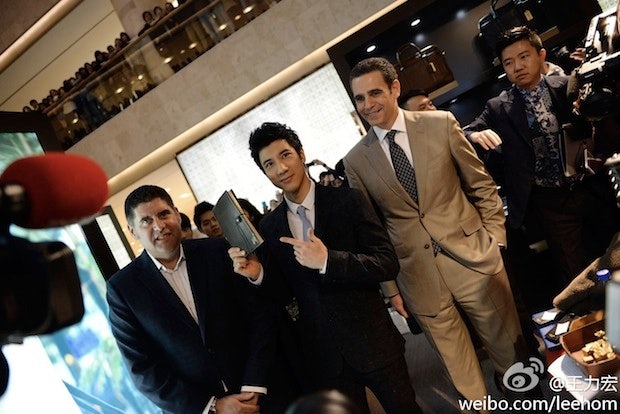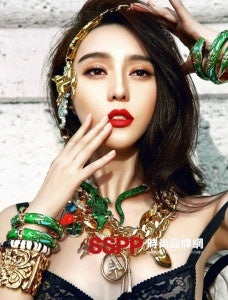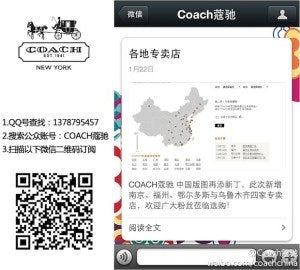From Weibo To WeChat, Savvy Ad Campaigns Deliver Outsized Results
#

Taiwanese actor Wang Lee-Hom in an interactive Weibo promotion for Coach. (Weibo)
This article originally appeared in Chinese.
With so many different forms of media in China, fashion brands must make a substantial investment in marketing and advertising, but these efforts often do not make the return on investment expected by the company. However, in the past three years, the appearance of social media has caused this situation to quietly change. The rise of social media channels such as Renren, Douban, Jiepang, Weibo, and more has given brands the opportunity to directly communicate with their target customers.
In the past, fashion brands used to advertise and promote via print magazines, but nowadays Weibo is the platform that can transfer a brand’s message in the fastest way, and provide immediate feedback and reactions from the specific customers targeted. Weibo not only serves to communicate information about the products and happenings, but also conveys a sense of the brand’s culture. As a result, fashion and luxury brands are becoming increasingly conscious of the importance of having an effective social media presence.
Because of the growing value social media marketing, international fashion and luxury companies need to better understand how they can create and benefit from a successful digital presence in China.
Fashionbi, the first Big database about all the digital marketing performances of Fashion and Luxury Brands, worldwide, published a research report about digital marketing strategies used by international brands. The report included an interview with Jeff Qiu, China general manager for Japanese fashion label Earth Music & Ecology, who said that “marketing through Weibo is a major up-and-coming platform for today's media. It is widely used by young people, and also very inexpensive to use. Therefore, it is important to promote on this outlet as part of a brand's marketing strategy as early as three months before entering the Chinese market."
Many international brands are now implementing this strategy of marketing on Weibo and gaining followers before they even arrive in the country. In addition, international brands that already have a presence in the country expend a generous amount of effort to promote on this platform before launching new products.
Also mentioned in the Fashionbi report is the importance of the "capital V" designation on Weibo--a symbol verifying the authenticity of the accounts of famous people and those with a large number of fans. This designation can do half the work of obtaining results.

Fan Bingbing's Anna Dello Russo for H&M ad that was transmitted on Weibo 30,000 times. (H&M)
Another strategy that can be employed by international brands is to facilitate interaction between users and celebrity brand ambassadors. A good example of this approach was last year's use of Fan Bingbing to promote the launch of the Anna Dello Russo for H&M Collection, which ended up being extremely popular on the social network. On the night before the collection's launch, the actress wore H&M's jewelry in an ad campaign that was promoted on Weibo by her style designer, Bu Kewen (Christopher Bu). This was one of H&M's most successful advertising campaigns: it was forwarded nearly 30,000 times, received more than 4000 comments, and resulted in many queries regarding where to buy the items. Before the campaign, few Weibo users knew who Anna Dello Russo was apart from few fashion lovers, but this example demonstrates that interactive online advertisement by well-known celebrities on Weibo can prove advantageous by giving way to increased offline activity. Ultimately, these strategies allow the brand to have a real impact on people and can raise sales targets.
In the world of online social interaction, there are several key performance indicators that cannot be ignored. Therefore, on Weibo, many international luxury brands are constantly interacting with "capital V" users who have huge numbers of fans. Some examples are Louis Vuitton and Fan Bingbing, Chanel and Yao Chen, and Coach and Leehom Wang. Major celebrity brand ambassadors are not the only focus for international brands, which also interact with popular "internet famous" users on Weibo. Take, for example, Italian brand Tod’s, which started out with only 50,000 fans. The brand entered into a collaboration with "Astrology Vivian (星座專家薇薇安)," a famous Weibo user with almost 6 million fans and the coveted capital V. After she shared Tod's Weibo account, the result of that one collaboration alone was that Tod’s audience expanded more than 10 times!
Today's relationship between brand and customer was not always one of dissemination to a target audience, but rather one of a stark division between buyer and seller. Psychologically, social media is now more of a soft sell, which can lead to certain challenges of its own. On one hand, brands want to promote themselves and have a lasting impact on their audience. Too much advertisement can jeopardize the fun of using Weibo, so a brand's goal should be to advertise without boring its audience. An inundation of ads on Weibo can lead to a loss of fans, so many brands' official Weibo accounts are now more like official mini-websites which display the label's brand culture and products.

Coach's WeChat account.
As mentioned on Fashionbi, the introduction of the Tencent Wechat public platform is changing social media networking in China. As Weibo was reaching its peak in August 2012, Tencent WeChat offered an innovative form of internet social interaction, and many brands started to develop and expand on this much more private and mobile network. After only a short half-year, brands including Louis Vuitton, Coach, Gucci, and many other major fashion and luxury brands joined this platform.
Among these brands, Louis Vuitton's development of social media in China has been much stronger than its efforts internationally. According to Fashionbi magazine, in October 2010, this brand was an early bird, opening an account on Sina Weibo as an official advertisement platform. Taking the strategy seriously, the company went local by selecting its Chinese name Luyi Weideng (路易威登). Later, in November 2012, the French luxury brand led the rest of its peers by joining the Wechat public platform in Sina Weibo, in contrast to competitors who thought that Wechat and Tencent Weibo users were too "young" and "low-consumption." Louis Vuitton, on the other hand, couldn’t resist reaching the 200 million WeChat users and an increasing number of mobile clients. It can be seen that the first well-known international brands to use the platform were quite optimistic about Chinese social networks.
As marketing on Weibo brand accounts and use of celebrities increasingly spreads, and as the use of WeChat expands, there is no doubt that a direct and friend-style private interactive experience between the brand and brand followers can be established. However, the problem in front of each brand is how to take advantage of the better online customer relationship management (CRM) to catch its "friend" and to keep a favorable interactive relation rather than being added to their blacklist.
Ma Mu#
is the Business Developer for Fashionbi, China.
(Opinions expressed by columnists do not necessarily reflect the views of the Jing Daily editorial team.)